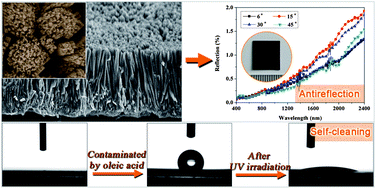We report excellent broadband and quasi-omnidirectional antireflective (AR) structures based on highly stable, self-cleaning, mesocrystalline rutile TiO2 nanorod arrays, which were grown by a facile hydrothermal synthesis directly on Ti foils. Typically, each hierarchical nanorod is a single-crystal-like rutile TiO2 mesocrystal comprising many [001]-oriented nanotips about 10–30 nm in diameter grown on the top of a [001]-oriented stem nanorod about 100–400 nm in diameter. These novel hierarchical mesostructures exhibit efficient suppression of reflection towards wavelengths ranging from visible to near infrared (NIR) region, with reflection <0.5% in the visible region and <2% in the NIR region, at a wide range of incident angles ranging from nearly normal to 45°. These excellent antireflection properties could be attributed to an optimized graded refractive index profile resulting from the hierarchical tips-on-rod structure of the mesocrystalline nanorods. The chemical and thermal stability of rutile TiO2 endows the prepared mesocrystalline TiO2 AR structures with high stability. Moreover, the AR structures exhibit useful self-cleaning properties either under UV irradiation or through fluorosilane-modification.

You have access to this article
 Please wait while we load your content...
Something went wrong. Try again?
Please wait while we load your content...
Something went wrong. Try again?


 Please wait while we load your content...
Please wait while we load your content...